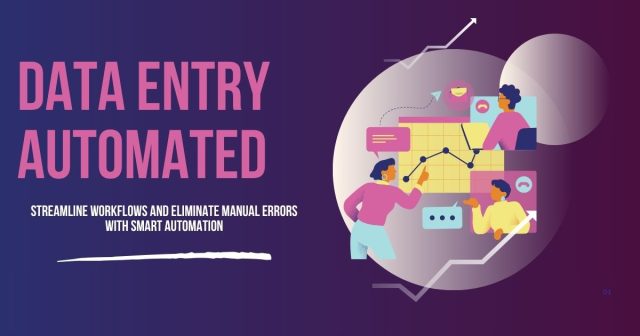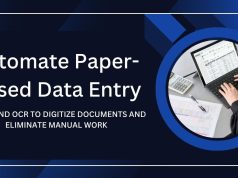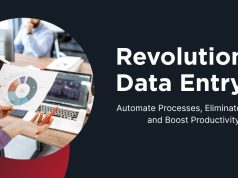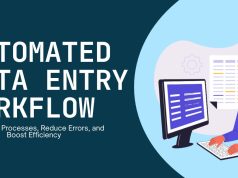Data entry is a critical component in the operations of most businesses. From maintaining accurate records to generating insights that drive decisions, data entry serves as the foundation for many organizational processes. But as companies evolve and digital transformation becomes the norm, a pressing question arises: can data entry be automated? The short answer is yes, and the benefits it provides can be game-changers for businesses.
This blog dives into how businesses can automate data entry, the tools and technologies involved, and the tangible benefits of adopting automation. By the end, you’ll understand not just if you can automate data entry but how you can harness it to drive efficiency and gain a competitive edge.
What Does Automating Data Entry Mean?
Before we jump into the specifics, it’s essential to understand what automated data entry entails. Automation involves using tools and software powered by artificial intelligence (AI), optical character recognition (OCR), or robotic process automation (RPA) to handle tasks traditionally performed by humans. Instead of manual inputting, these systems extract, sort, and process data without human intervention.
For example:
- A traditional accounts department manually enters receipts into a spreadsheet.
- With automation software, the receipts are scanned, and the software reads, organizes, and records the data into appropriate fields in seconds.
Why Automate Data Entry? The Core Benefits
Businesses that automate data entry often see an immediate and significant improvement in operational efficiency. Here are the main benefits:

1. Saves Time
Manual data entry can be tedious and time-consuming, especially for large datasets. Automation processes data faster, allowing teams to focus on higher-value tasks instead.
Example: Automating invoice entry can process hundreds of records in minutes instead of hours or days.
2. Reduces Errors
Humans are prone to mistakes, especially when dealing with repetitive tasks. Automation ensures more accurate data handling, reducing costly errors.
Example: An auto-fill tool can eliminate typos in customer information fields.
3. Cost Efficiency
While automation tools require upfront investment, they drastically reduce operational costs over time by minimizing dependency on labor-intensive manual processes.
4. Enhanced Scalability
As your business grows, so does your data. Automated systems can handle increasing data volumes without needing additional manpower.
5. Real-Time Data Access
Automation provides instant data processing, allowing businesses to work with real-time insights rather than relying on outdated information.
Key Technologies Used in Automated Data Entry
Several cutting-edge technologies enable businesses to automate data entry efficiently. Here’s an overview of the most commonly used ones:
1. Optical Character Recognition (OCR)
OCR technology converts scanned documents, PDFs, or images of text into editable and searchable data. It’s particularly useful for digitizing printed materials.
Example: A logistics company uses OCR to extract data from shipping labels and invoices automatically.
2. Robotic Process Automation (RPA)
RPA deploys virtual robots to perform repetitive, rule-based tasks, like transferring data between systems or generating reports.
Example: An HR department employs RPA to extract, verify, and organize candidate information from resumes.
3. Artificial Intelligence (AI)
AI-powered tools not only process data but also learn and adapt from patterns in the data over time, offering smarter insights and enhanced accuracy.
Example: AI predicts errors in data entries and flags them for review.
4. Application Programming Interfaces (APIs)
APIs enable seamless integration between different software and systems, facilitating automated data syncing in real-time.
Example: APIs connect your CRM system with an e-commerce platform to sync order data instantly.
Popular Use Cases for Automating Data Entry
Businesses across industries have successfully embraced automation for various data entry tasks. Here are some of the most impactful use cases:
1. Customer Relationship Management (CRM)
Automating data entry into CRM systems ensures consistent and accurate records of customer interactions, purchase history, and contact details.
Example: Salesforce automatically syncs lead information from website forms.
2. Invoice and Expense Processing
OCR and RPA streamline financial processes by scanning invoices, extracting data, and reconciling it with purchase orders.
Example: Accounts payable systems like Bill.com reduce manual intervention by digitizing payment processes.
3. E-commerce and Inventory Management
Automation tools keep inventory and order records updated, ensuring customers won’t place orders for out-of-stock items.
Example: Shopify uses automation to sync sales data with inventory levels in real time.
4. Healthcare
Data entry in healthcare often involves digitizing large volumes of sensitive patient records, an area where automation ensures accuracy and speed.
Example: Tools like DocuTap convert written prescriptions into digital records.
5. Human Resources and Recruiting
Automation reduces the burden of entering and updating applicant or employee data across multiple systems.
Example: Greenhouse ATS integrates automation to parse resume data and match it with open roles automatically.
Steps to Automate Data Entry for Your Business
Implementing data entry automation might seem daunting, but a structured approach makes the process seamless. Here’s how to get started:
1. Identify Processes to Automate
Evaluate your current workflow to pinpoint areas where manual data entry consumes the most time and resources.
2. Choose the Right Tools
Research software solutions that align with your business needs. Look for scalability, user-friendliness, and integration capabilities.
3. Train Your Team
Ensure that your employees understand how to use the new system. Training helps mitigate resistance to change and maximizes efficiency.
4. Test the System
Run a pilot program to verify the system works flawlessly and identify potential glitches or areas for optimization.
5. Monitor and Optimize
Automation isn’t a one-and-done process. Continuously monitor its performance, gather feedback, and fine-tune the configurations.
Challenges of Automating Data Entry (and How to Overcome Them)
While the benefits are significant, transitioning to automation comes with challenges. Here’s how to tackle them:
1. High Initial Investment
Solution: Start with small-scale automation to prove ROI before scaling up.
2. Integration Issues
Solution: Choose automation tools that support API integration for seamless connectivity.
3. Lack of Expertise
Solution: Leverage training programs or hire consultants to guide the automation process.
Is Data Entry Automation the Right Move for Your Business?
If you’re questioning whether data entry can be automated, the answer lies in evaluating your operational needs. Automation isn’t just for large enterprises; even small businesses can benefit greatly from implementing automated data entry processes.
Tools like OCR, RPA, and AI empower businesses with better accuracy, speed, and scalability. By automating repetitive tasks, businesses free valuable resources that can be redirected toward strategic goals.
Start exploring the possibilities today and take the first step toward greater efficiency. The future of data entry is here, and it’s automated.
As businesses explore automation to streamline tasks like data entry, leveraging tools such as Google Analytics becomes essential for turning that data into actionable marketing insights—bridging operational efficiency with strategic decision-making.










